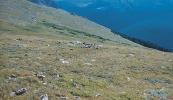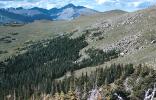

Alpine tundra occurs throughout the western mountain ranges above timberline, with considerable amounts of wasteland, rocky- inaccessible areas, cliffs, and small mountain meadows. On broad mountain tops it can be quite extensive.
Climate. The climate is characterized by low temperatures and short growing season (often no more than 2 months) and by frozen subsoil and poor drainage. Often temperatures can go from 50 C on a July day to below freezing that night. (Incidentally solar energy is high there due to the reduced atmospheric influence). Snow covers the area 9 to 10 months of the year. Annual precipitation averages 90 to 125 centimeters, but evaporation is high.
Soils. Soils of the alpine tundra are relatively fragile and subject to erosion when disturbed. Most are poorly developed (Entisols), but some have weak horizonation (Inceptisols). Spodosols are present in some areas also.
Vegetation. Low-growing sedges and grasses dominate the tundra. Among the important species are the sedge, (Kobresia bellardii), bluegrasses, tufted hairgrass (Dechampsia caespitosa), sedges, (Carex sp.) and willows (Salix sp.). Numerous forbs are associated with this type.
Management. The alpine tundra provides summer grazing for sheep in many areas, and serves as a significant watershed and wildlife resource area. The area also provides significant recreation for hikers and backpackers.